One of art history's satisfactions is its vocabulary. Required to address things visual, the field has invented and/or borrowed a number of terms to allow for the simple naming of frequently-encountered complicated forms. Isocephalic is one of my favorites; it describes a group of figures whose heads are all set at the same level, and comes in quite handy when describing some classical reliefs or early Christian mosaics.
One of teaching's satisfactions is learning new things from students. Which leads me to today's word, ipsilateral: "Belonging to or occurring on the same side of the body; connecting two parts on the same side," according to the OED. I learned this word from a student who used it in a visual analysis on this great piece, a wine pitcher from Greece dating to about 470 BCE that was painted by a prolific artist named Douris.

[Red-Figure Oenochoe with Running Satyr, Allen Memorial Art Museum, R. T. Miller, Jr. Fund, 1955.11, photo from Allen site]
The pot shows a satyr in motion (running? springing?) from right to left. Without the word, you would have to say that the satyr's proper right arm and proper right leg are both extended before him, and his proper left arm and proper left leg are extended behind him, which is a mouthful. With the word, you can simply say "the satyr's limbs move ipsilaterally," which is shorter, accurate, and satisfying. I like this word a lot. So much so that I proudly told my wife that I'd learned a new word from a student paper. Turns out, my wife knew it already from yoga, and immediately predicted: "I bet that student is a dancer or does yoga, or both," as these are other arenas in which the word is very useful. A quick google also finds 'ipsilateral' used to describe the physical effects of strokes, another field where the term is convenient.
The visual analysis was written for my intro class, Themes in Western Art History, in which all the students had to analyze the composition of an ancient Greek or Roman work in the Allen. With the museum reopened there were close to four dozen works to pick from on display. This one's a real charmer. After distinguishing the spout's division from the body with a horizontal band of ornament, Douris placed the satyr's head directly below the spout, and extended his limbs ipsilaterally (!) so that he occupies all the surface space that a viewer can take in with one glance, without needing to turn the pot. When one looks closely, the composition's apparent simplicity reveals the design's intelligence. Discovering the painter's savvy is one of the rewards of close looking, and the chance to do that close looking was one of the satisfactions of grading these papers.



